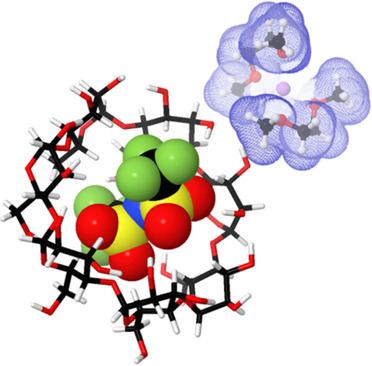当前位置:
X-MOL 学术
›
ChemSusChem
›
论文详情
Our official English website, www.x-mol.net, welcomes your feedback! (Note: you will need to create a separate account there.)
Catching TFSI: A Computational–Experimental Approach to β‐Cyclodextrin‐Based Host–Guest Systems as electrolytes for Li‐Ion Batteries
ChemSusChem ( IF 8.4 ) Pub Date : 2018-04-16 , DOI: 10.1002/cssc.201800221 Steffen Jeschke 1 , Piotr Jankowski 2 , Adam S. Best 3 , Patrik Johansson 1
ChemSusChem ( IF 8.4 ) Pub Date : 2018-04-16 , DOI: 10.1002/cssc.201800221 Steffen Jeschke 1 , Piotr Jankowski 2 , Adam S. Best 3 , Patrik Johansson 1
Affiliation

|
Cyclodextrins (CDs) are pyranoside‐based macromolecules with a hydrophobic cavity to encapsulate small molecules. They are used as molecular vehicles, for instance in pharmaceutical drug delivery or as solubility enhancer of monomers for their polymerization in aqueous solution. In this context, it was discovered about 10 years ago that the bis(trifluoromethylsulonyl)imide (TFSI) anion forms host–guest complexes with βCD in aqueous media. This sparked interest in using the TFSI anion in lithium‐based battery electrolytes open for its encapsulation by βCD as an attractive approach to increase the contribution of the cation to the total ion conductivity. By using semi‐empirical quantum mechanical (SQM) methods and the conductor‐like screening model for a real solvent (COSMO‐RS), a randomly methylated βCD (RMβCD) is here identified as a suitable host for TFSI when using organic solvents often used in battery technology. By combining molecular dynamics (MD) simulations with different NMR and FTIR experiments, the formation of the corresponding RMβCD–TFSI complex was investigated. Finally, the effects of the addition RMβCD to a set of electrolytes on the ion conductivity are measured and explained using three distinct scenarios.
中文翻译:

捕捉TFSI:基于β-环糊精的宿主-客体系统作为锂离子电池电解质的计算-实验方法
环糊精(CDs)是基于吡喃糖苷的大分子,具有疏水腔以包裹小分子。它们被用作分子载体,例如在药物递送中,或作为单体在水溶液中聚合的溶解度增强剂。在这种情况下,大约10年前发现双(三氟甲基亚磺酰基)酰亚胺(TFSI)阴离子在水性介质中与βCD形成主体-客体复合物。这引起了人们的兴趣,即将在锂基电池电解液中使用TFSI阴离子以通过βCD进行包封作为一种吸引人的方法,以增加阳离子对总离子电导率的贡献。通过使用半经验量子力学(SQM)方法和类似导体的真实溶剂筛选模型(COSMO-RS),当使用电池技术中经常使用的有机溶剂时,随机甲基化的βCD(RMβCD)在这里被确定为TFSI的合适宿主。通过将分子动力学(MD)模拟与不同的NMR和FTIR实验相结合,研究了相应的RMβCD-TFSI配合物的形成。最后,使用三种不同的方案测量并解释了将RMβCD添加到一组电解质中对离子电导率的影响。
更新日期:2018-04-16
中文翻译:

捕捉TFSI:基于β-环糊精的宿主-客体系统作为锂离子电池电解质的计算-实验方法
环糊精(CDs)是基于吡喃糖苷的大分子,具有疏水腔以包裹小分子。它们被用作分子载体,例如在药物递送中,或作为单体在水溶液中聚合的溶解度增强剂。在这种情况下,大约10年前发现双(三氟甲基亚磺酰基)酰亚胺(TFSI)阴离子在水性介质中与βCD形成主体-客体复合物。这引起了人们的兴趣,即将在锂基电池电解液中使用TFSI阴离子以通过βCD进行包封作为一种吸引人的方法,以增加阳离子对总离子电导率的贡献。通过使用半经验量子力学(SQM)方法和类似导体的真实溶剂筛选模型(COSMO-RS),当使用电池技术中经常使用的有机溶剂时,随机甲基化的βCD(RMβCD)在这里被确定为TFSI的合适宿主。通过将分子动力学(MD)模拟与不同的NMR和FTIR实验相结合,研究了相应的RMβCD-TFSI配合物的形成。最后,使用三种不同的方案测量并解释了将RMβCD添加到一组电解质中对离子电导率的影响。



























 京公网安备 11010802027423号
京公网安备 11010802027423号